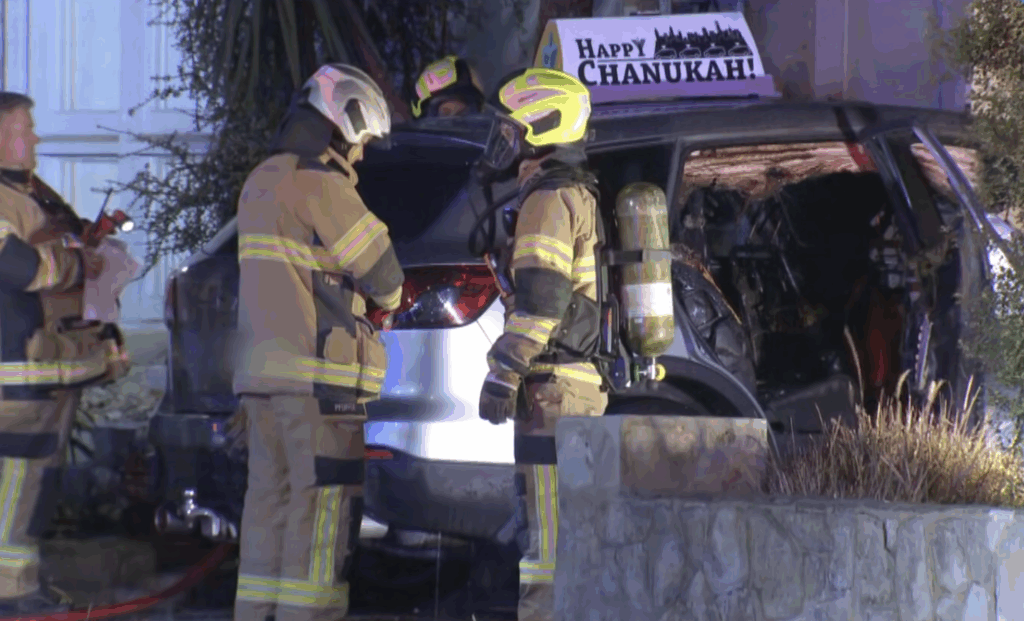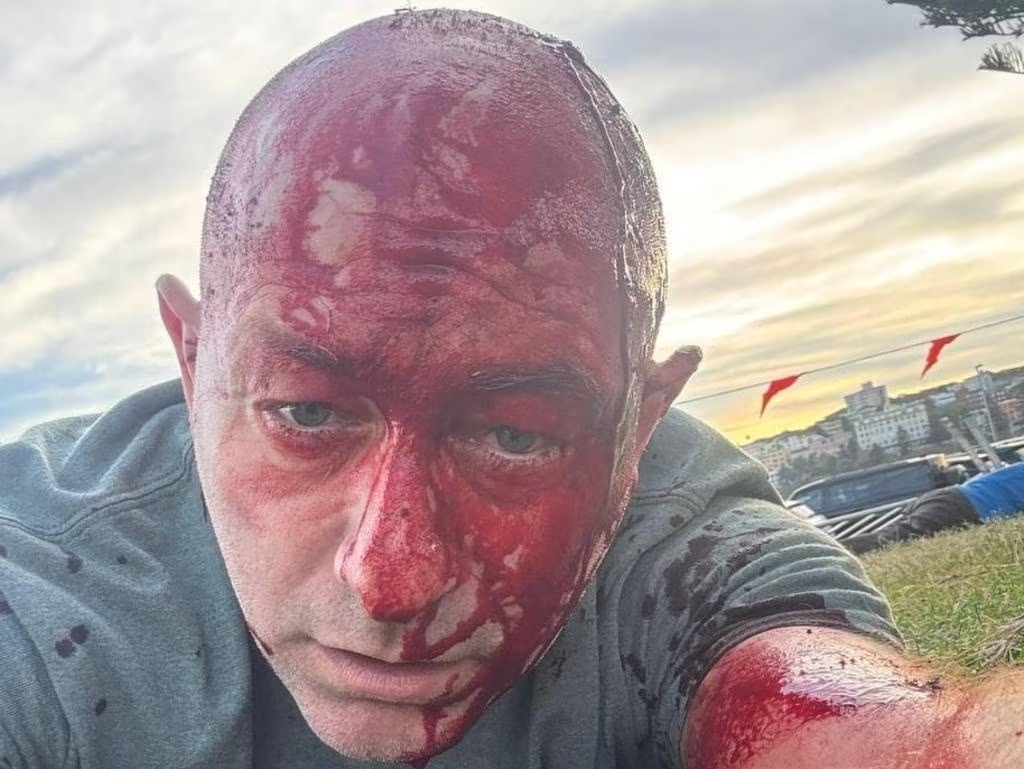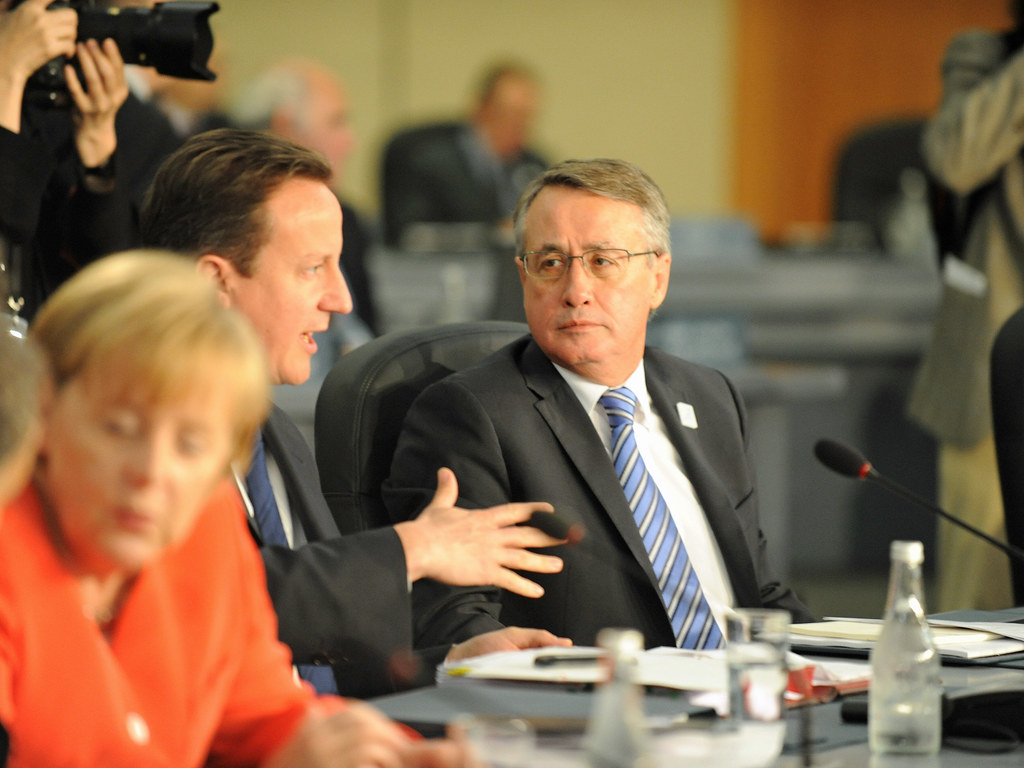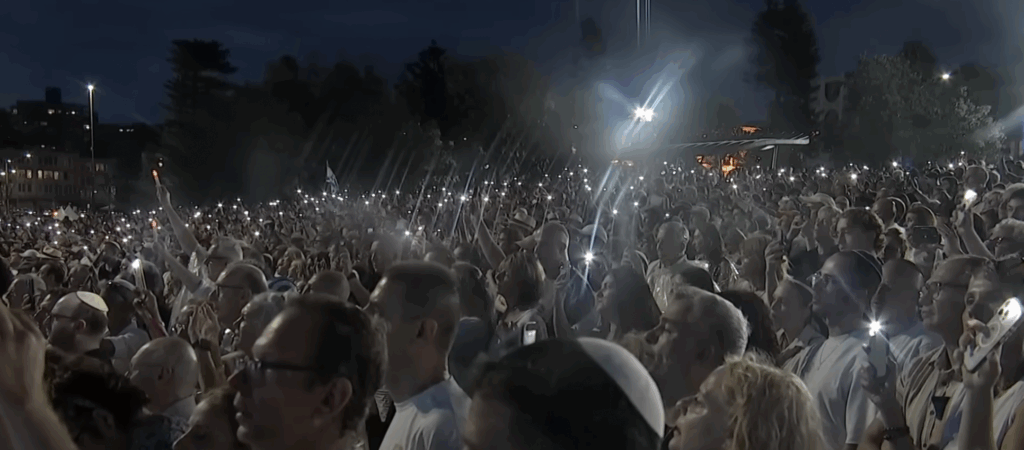FACT SHEETS
Far-Right extremism
August 4, 2025 | AIJAC staff
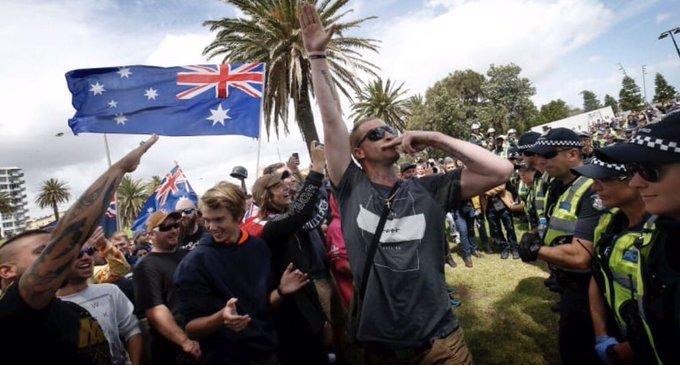
Originally published March 9, 2021. Updated August 4, 2025
Key points
- The strength and number of far-right groups has grown significantly in recent years
- The Australian Security Intelligence Organisation states that far-right groups are more organised and security-conscious than ever before
- The first far-right group was proscribed as a terrorist organisation in Australia in 2021
- There have been multiple far-right terror attacks across the world in the past decade
- Many COVID-19 conspiracy theories blame Jews for the virus or for profiting from it
- Jewish communities remain a target of far-right groups
Contents
- Summary
- What is far-right extremism?
- Growth of far-right violence across the world
- Far-right extremism in Australia
- Far-right threat to Jewish communities
- Threats to Jewish communities in Australia
- COVID-19 and the far-right
- Legislative reform and education
Summary
Far-right extremism is a politically-motivated ideology that includes white supremacy, Neo-Nazism, ultra-nationalism, antisemitism, hatred of Muslims, racism, and anti-immigration. It also tends to be deeply embedded in anti-government beliefs and conspiracy theories and promotes hateful messages. Far-right extremism has been growing in recent years, including in Australia – especially during the COVID-19 pandemic. Over the past decade, there have been multiple massacres and other violent attacks committed by far-right extremists across the world.
What is far-right extremism?
Far-right extremism is a politically-motivated ideology that falls under the umbrella term ‘ideologically motivated violent extremism’ (IMVE). While there are several different types of far-right extremism, groups and individuals generally share a fundamental opposition to mainstream society, idealising a ‘revolution’ in the name of the white or “Aryan” race, promote and share their extremist views online and draw inspiration from each other.
Many modern far-right groups are inspired by terror attacks carried out by other far-right groups, including the 2019 Christchurch terror attack. They also often support the ‘White-Replacement Theory,’ which is the belief that white or indigenous European people are being replaced by People of Colour in countries across the world, including Australia. The theory blames “The Jews” for the “demise and destruction” of ‘white culture and civilisation,’ and advocates for the downfall of Western governments across the world in order to create radical social change and establish a whites-only ethnostate.
Read more: “The Far-Right foreign fighter threat that wasn’t”
Growth of far-right violence across the world
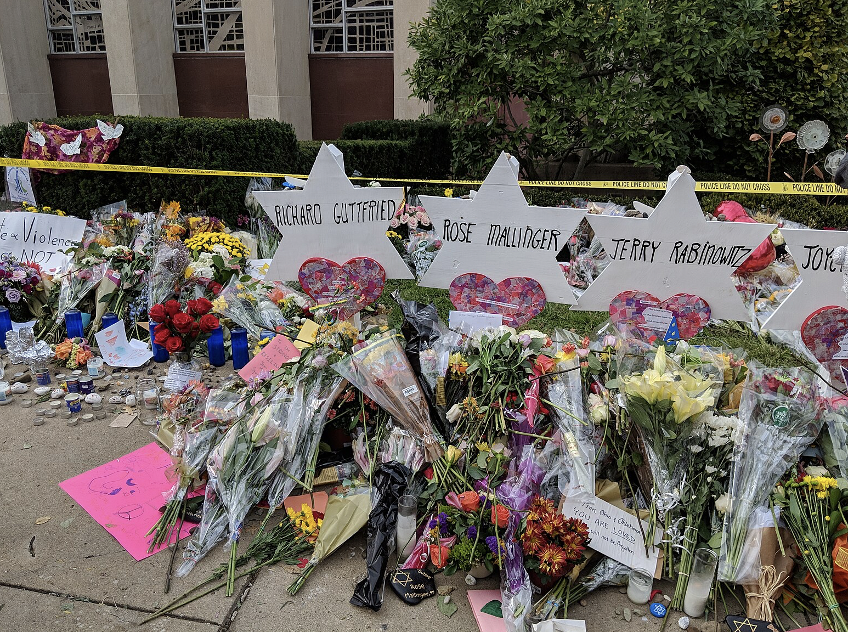
A memorial at the Tree of Life Synagogue in Pennsylvania, 2018 (Image: Wikimedia Commons)
Across the world – including in Australia – there has been a significant growth in far-right extremist groups and ideology, as well as violent attacks. Violent attacks by far-right extremist groups and individuals that have occurred across the world include:
- 2022: Izhevsk school shooting that killed 18 people (Russia)
- 2022: Colorado Springs nightclub shooting that killed 25 people (United States)
- 2021: Capitol Hill riots that killed five (United States)
- 2019: Christchurch massacre that killed 51 people in two mosques (New Zealand)
- 2019: El Paso Walmart attack that killed 23 people (United States)
- 2019: Halle synagogue attack that killed two people (Germany)
- 2019: Poway synagogue shooting that killed one person and injured three others (United States)
- 2018: Tree of Life Synagogue shooting that killed 11 people (United States)
- 2015: Charleston church shooting that killed nine people in South Carolina (United States)
- 2011: Oslo car bombing and Utøya shooting that killed 77 people (Norway)
A new wave of far-right extremism is being bred online through ‘toxic masculinity’ influencers, such as Andrew Tate, a self-described misogynist and alleged rapist who has a huge following and has inspired the trend.
Read more: “Understanding the security threat from violent extremists”
Far-right extremism in Australia
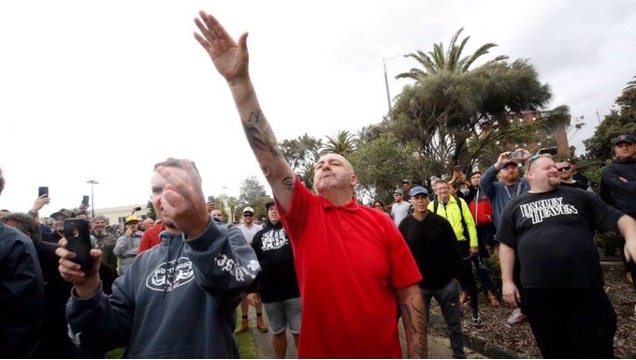
Far-right extremists at a rally in Melbourne in 2019 (Image: @cjwerleman)
In Australia, the overwhelming majority of far-right extremist activities are characterised by intimidation, threats and harassment in the form of phone calls and letters, graffiti and vandalism and noxious remarks and gestures, including the Nazi salute. While far-right extremism has long existed in Australia, its popularity and threat has grown significantly in recent years, partly influenced by international far-right groups that spread their ideologies online and use social media to attract and recruit new followers.
In February 2021, the Australian Security Intelligence Organisation (ASIO) confirmed that far-right groups are more organised, sophisticated and security-conscious than in the past.
The then-Morrison Government added Sonnenkrieg Division (SKD), a group active in the United Kingdom and Europe, to Australia’s list of banned terrorist organisations. It was the first time a far-right organisation was proscribed in Australia. In March 2021, then-Minister for Home Affairs Peter Dutton said that SKD had an “abhorrent, violent ideology that encourages lone-wolf terrorist actors who would seek to cause significant harm to our way of life and our country”.
A 2022 Australian Parliamentary report stated that far-right extremism has “become more visible and a growing threat to national security”.
It further stated:
The rise of social media, both mainstream and alternative, as well as encrypted messaging services, has allowed groups and individuals to share ideas and build community with like-minded people. Groups have been able to connect with individuals, particularly young people who felt physically and socially isolated, perhaps bonding over one shared grievance before drawing in further beliefs.
In 2024, ASIO reported that about 25% of their counter-terrorism efforts were directed towards far-rightextremist activities. This is a drop from 2020, when it was reported that approximately 40 per cent of its counter-terrorism efforts were dedicated to far-right extremist activities.
In a submission to a 2024 Senate inquiry into right-wing extremist movements in Australia, ASIO stated, “we assess the vast majority of established nationalist-and-racist groups are more likely to focus on recruitment and radicalisation rather than attack planning in the foreseeable future”. ASIO added that the reach of extremist content online is resulting in individuals becoming radicalised “very quickly – in days and weeks”. Extremists are increasingly using non-mainstream social media forums, including those with end-to-end encryption, to find and recruit new members.
Although he did not specifically mention far-right extremism, in his 2025 speech about Australia’s annual security threat assessment, Mike Burgess, ASIO’s Director-General of Security, said that “to 2030, we expect politically motivated violence to remain an elevated concern”.
“Of all the potential terrorist matters investigated last year, fewer than half were religiously motivated. The majority involved mixed ideologies or nationalist and racist ideologies,” Burgess said, adding that the median age at which minors are first subject to being investigated by ASIO is just 15. Minors are also overwhelmingly male, at 85%.
“Politically motivated violence is raising the temperature of the security environment and making acts of terrorism more likely.”
In recent years, new groups have emerged and existing groups have become even more radicalised and increased their membership numbers. In October 2020, the Australian Federal Police (AFP) reported on the rise of young people being aggressively radicalised online by the far-right.
Recent examples of far-right extremist activity in Australia include:
- 2024: National Socialist Network member Jacob Hersant became the first person found guilty of breaking Victorian state law against performing the Nazi salute in public
- 2023: Tamworth man Wade Homewood was sentenced to 2 years and 4 months after pleading guilty to advocating for terrorist acts in multiple social media posts, plus a firearms offence
- 2020: Phillip Galea, a member of Reclaim Australia and the True Blue Crew, was found guilty of preparing to carry out a terrorist act and making a document likely to facilitate a terrorist act
- 2020: The AFP charged two men in New South Wales with terrorist offences, alleging they were planning to purchase military equipment, including guns and bomb-making equipment. These men had links to far-right supporters in the UK, and an arrest was made there as well
- 2020: Albury man Tyler Jakovac was charged with urging violence against members or groups and advocating terrorism. Police allege he used the messenger service Telegram to urge the killing of “non-whites, Jews and Muslims.” Jakovac allegedly used a far-right group that featured Nazi symbolism to urge violence against other races and religions
- 2017: White supremacist Michael Holt was jailed for 4.5 years for stockpiling homemade guns and weapons across Sydney and expressed an intention to commit a mass shooting at a Westfield shopping centre
In Australia, there is a range of far-right groups, movements and far-right-motivated individuals that have been active in recent years, many with connections to international groups. Some are new, while others have merged together. These include Reclaim Australia, which turned into the True Blue Crew and the United Patriots Front; The United Patriots Front became the Lads Society, and in 2018, the Lads Society infiltrated the Young Nationals. The Lads Society gave way to the National Socialist Network, led by Thomas Sewell. There was also the now-defunct Antipodean Resistance – a Neo-Nazi hate group formed in 2016, which went by the slogan “We’re the Hitlers you’ve been waiting for” and used the swastika symbol and Nazi salute. The group promoted and incited hatred and distributed racist, homophobic and antisemitic posts and propaganda. In 2018, its website was shut down by its hosting provider.
Today, far-right groups and movements in Australia include: The National Socialist Network, the Proud Boys, Sonnenkrieg Division, QAnon, The Base, the Australian Defence League, Right Wing Resistance, the Nationalist Australian Alternative, Soldiers of Odin, the Patriotic Youth League, Blood and Honour, and the Australian Nationalist Movement.
However, ASIO Director-General of Security Mike Burgess said in February 2025 that traditional political distinctions between extremists was being increasingly blurred, and therefore harder to clearly classify”
Individuals are cherry-picking seemingly antithetical ideologies to create new, hybrid beliefs. In one case last year, we found an individual apparently motivated by Islamic State propaganda and neo-Nazi propaganda. In another, an individual allegedly described himself as a left-wing environmentalist aligned with Adolf Hitler. This diversity is expected to escalate – and further diversify.
Read more: “Focus on the Australian far-right”
Far-right threat to Jewish communities

Far-right extremist Jackson Hinkle (Image: Wikipedia)
Jewish communities across the world, including in Australia, have long been targets and victims of far-right extremism. In Germany, the Nazis blamed Germany’s defeat in World War I on Jews and claimed the Jewish people were an inferior race that had to be eradicated.
The ideology of Adolf Hitler, as laid out in his 1925 part-autobiographical manifesto, Mein Kampf, included ideas of racial supremacy and conspiracies about Jewish power that were partly based on the infamous 19thcentury Russian forgery The Protocols of the Elders of Zion.
Post the October 7, 2023, terror attacks in southern Israel, antisemitism has exploded across the world, in all forms of extremism including Islamist, far-right, and far-left. And it was revealed that online far-right forums were used to plan a series of UK riots targeting Jewish people in August 2024.
Several high-profile far-right individuals, including Jackson Hinkle, Lucas Gage, Jake Shields and Sam Parker, have aggressively increased their antisemitic and anti-Zionist rhetoric and conspiracy theories against Jews and Israel to their large bands of followers online.
In recent years, Jews – particularly in the United States and across Europe – have been the target of multiple far-right extremist terror attacks, including the 2018 shootings at the Tree of Life Synagogue in Pittsburgh, where a white supremacist killed 11 people, as well the Chabad of Poway synagogue shooting, in California, that killed one person and injured three others.
In 2019 in Germany, a far-right extremist attempted to enter the Halle Synagogue on the Jewish Holiday of Yom Kippur and when the attacker couldn’t gain access, he shot and killed two people nearby. German federal investigators classified the attack as far-right and antisemitic terrorism.
Prominent antisemitism from far-right groups was on display during the US Capitol riots in January 2021. For example, one person wore a tee-shirt displaying an image of a skull and bones, the words “Camp Auschwitz” and the notorious phrase “work brings freedom”. Another person wore a tee-shirt inscribed with “6MWE,” which is an acronym common among the far-right, which stands for “6 Million Wasn’t Enough”.
Threats to Jewish communities in Australia
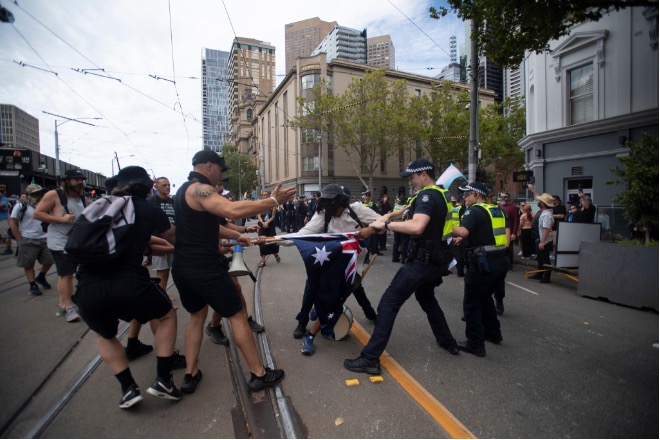
A confrontation between far-right extremists and police in Melbourne, 2023 (Image: Alamy)
The Australian Jewish community remains deeply concerned by the threat from extremists, including the far-right. In Australia, many Jewish schools, synagogues and community centres have long been forced to use security guards and install security systems.
In late 2024, the Executive Council of Australian Jewry (ECAJ) released its latest report on antisemitic incidents, which revealed a 316% increase in reported antisemitic incidents across Australia between 1 October 2023 to 30 September 2024.
The report noted that the 2,062 antisemitic incidents reported came from a variety of sources, including Islamist, far-right and far-left. These incidents included antisemitic physical assaults, verbal abuses, vandalism and graffiti, messages and posters/stickers.
The report highlighted examples including neo-Nazi group, Australian European Movement, distributing leaflets “Calling all White Australians” across the Gold Coast suburbs of Labrador, Southport, and Biggera Waters.
The Australian Jewish community benefits from and appreciates Commonwealth support towards security costs, including under the Safer Community Fund grants.
Read more: “Submission to the Inquiry into Extremism in Victoria”
COVID-19 and the far-right
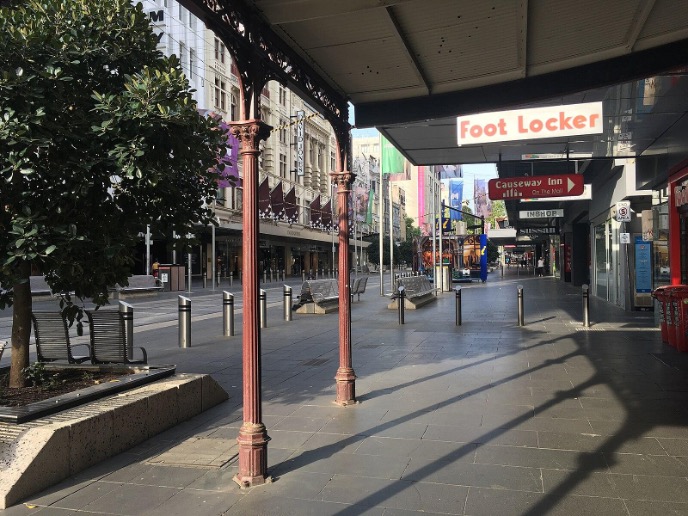
The Melbourne CBD during the Covid-19 lockdown (Image: Wikimedia Commons)
Many far-right movements sought to take advantage of conspiracy theories related to the COVID-19 pandemic, especially those that supported their opposition to lockdowns and mandatory vaccination.
ASIO reported in June 2020:
COVID-19 restrictions are being exploited by extreme right-wing narratives that paint the state as oppressive, and globalisation and democracy as flawed and failing.
We assess the COVID-19 pandemic has reinforced an extreme right-wing belief in the inevitability of societal collapse and a ‘race war’.” The pandemic has also led to the proliferation of antisemitic conspiracy theories online attempting to connect Jews and Israel to the coronavirus crisis.
Some conspiracy theories accused Jews and Zionists of orchestrating the pandemic for the purposes of “global domination,” in order to impose a “New World Order” and for profit.
Antisemitic content was also spread widely online using the #COVID48 hashtag, which compared Israel to the virus itself and reflected historic antisemitic depictions of Jews as ‘viruses’ seeking to take over the world.
Read more: “The latest Coronavirus Conspiracy Theories from the Middle East and far right”
Legislative reform and education
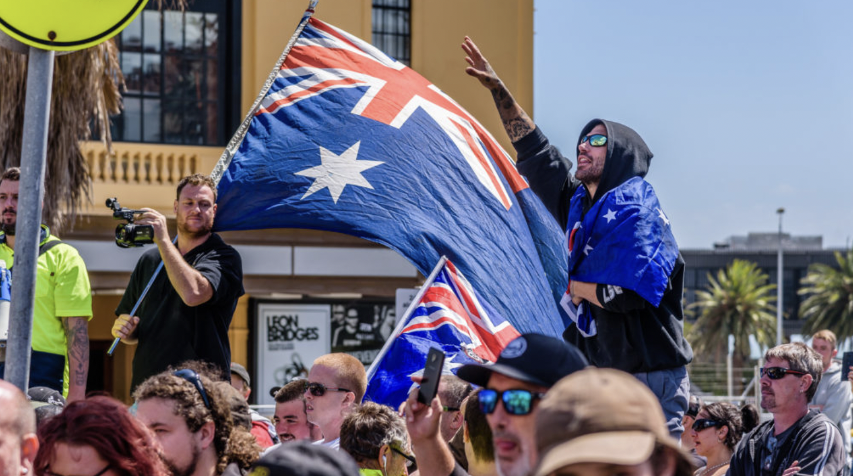
A crowd of far-right extremists in 2021 (Image: Shutterstock)
In 2022, several Australian states started to introduce laws banning the public performance of the Nazi salute and the public display of the Nazi symbol (Hakenkreuz). In January 2024, a federal law banning both and covering all of Australia came into effect. The law also bans the trade of Nazi items.
In 2021, the Sonnenkrieg Division extremist group (SKD) was added to Australia’s list of banned terrorist organisations. Deakin University academic Joshua Roose said the ban was “more likely linked to an ally banning them than any strong presence on the ground in Australia”. The following year, neo-Nazi group National Socialist Order was proscribed. Three other far-right extremist groups have been proscribed: The Base (2021), National Socialist Order (2022), and Terrorgram (2025).
Other Western countries have also proscribed far-right groups. By July 2021, the United Kingdom has banned five Neo-Nazi groups, including National Action in 2016 and SKD in 2020. Members of various far-right groups have been convicted of terror-related and other crimes across the UK.
Neo-Nazi group Combat-18 is proscribed in both Germany and Canada, but it doesn’t have a similar listing in Australia, despite being linked to the 2010 shooting at a Perth mosque. The men involved in that incident did not face terror charges but were instead prosecuted for causing criminal damage, discharging a firearm from across a road and possessing an unlicensed firearm.
Moreover, Neo-Nazi group Blood and Honour, which is active in Australia, is banned in several countries including Germany, Russia and Canada.
In February 2021, Canada became the first jurisdiction in the world to list the Proud Boys – a white supremacist group that was allegedly heavily involved in the 2021 storming of the US Capitol – as a terrorist entity. At the same time, Canada’s Public Safety Minister also designated groups The Base and the Atomwaffen Division (AWD). These listings allow Canadian police to freeze these groups’ assets and charge anyone who supports them. These listings also make it more difficult for these groups to operate in a meaningful way in Canada.
In January 2025, the Albanese Government released its counter-terrorism and violent extremism strategy. It stated,
The threat from ideologically motivated violent extremism, particularly transnational and domestic nationalist and racist violent extremism, also persists as white nationalist groups attempt to recruit individuals, put them on the path to extreme violence, and seek public attention and support to assist those efforts.
Nationalist and racist violent extremist views persist, and adherents are weaving new issues into their conspiracy theories and anti-establishment views.
Holocaust education remains an integral instrument in teaching young people not just about the horrors of the Shoah, but to educate much more broadly in countering the danger of extremism and the growth in hatred. The shocking results of a 2020 survey revealed that 63% of Millennials and Gen Z in the US didn’t know that six million Jewish people were murdered in the Holocaust, and one in ten hadn’t even heard of the word ‘Holocaust’ before.
Research has shown that Holocaust education provides multiple benefits, including teaching empathy and tolerance – not just for Jewish people, but for all people, regardless of race, religion or culture. While education about the Holocaust is included in the Australian curriculum, currently it’s only mandatory in Victoria and New South Wales.
Holocaust education on its own is not sufficient to stop antisemitism and racism, but it can help counter religious, racial and political sources of hatred. It can also teach lessons that promote respect for democracy and human rights, as students learn how easily Germany degenerated from a functioning democracy into a totalitarian dictatorship. This awareness can help prevent young people from being attracted to extremism or becoming bystanders to it.
Read more: “Russia is the Iran of White Supremacy”
Tags: ASIO, Antisemitism, Australia, Far Right, Nazi, conspiracy theory, neo-Nazi

